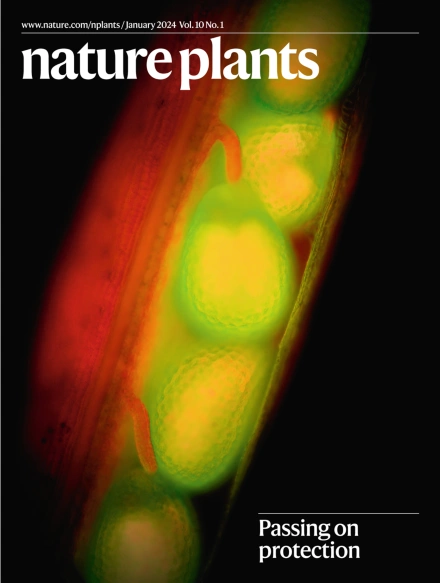外胞体pH是下胚轴生长对生长素剂量和光照响应的关键决定因素
IF 15.8
1区 生物学
Q1 PLANT SCIENCES
引用次数: 0
摘要
生长素是调控植物伸长生长的核心激素。虽然生长素通常促进下胚轴的伸长,但过量的生长素会抑制伸长。此外,生长素通常促进光生长,但抑制暗生长的下胚轴伸长。剂量和光照条件如何改变植物对生长素的反应,也被称为生长素的双相效应或双重效应,长期以来一直是个谜。生长素主要通过胞外酸化和随后的“酸性生长”机制诱导细胞扩增。在这里,我们表明这一途径在刺激和抑制生长素剂量下以及在黑暗和光明条件下都起作用。无论剂量如何,更多的生长素诱导更多的SAURs(小生长素- up rna)转录,导致质膜H+- atp酶(AHAs)的更强激活和下胚轴表皮外质体的逐渐酸化。外胞体酸化促进生长,但仅高于一定的pH值,低于此值过度酸化抑制伸长。生长素过量引发的下胚轴抑制可以通过抑制AHA活性或提高外胞体pH来缓解。光照下生长的下胚轴表现出较高的外胞体pH,这阻碍了细胞伸长并抵消了生长素诱导的过酸化。生长素和光拮抗调节SAUR-PP2C。D-AHA通路影响植物下胚轴伸长生长。我们的研究结果表明,生长素的双相效应是由下胚轴细胞对降低的胞外pH值的双相反应引起的。本文章由计算机程序翻译,如有差异,请以英文原文为准。


The apoplastic pH is a key determinant in the hypocotyl growth response to auxin dosage and light
Auxin is a core phytohormone regulating plant elongation growth. While auxin typically promotes hypocotyl elongation, excessive amounts of auxin inhibit elongation. Moreover, auxin usually promotes light-grown, but inhibits dark-grown hypocotyl elongation. How dosage and light condition change the plant’s response to auxin, also known as auxin’s biphasic effect or dual effect, has long been mysterious. Auxin induces cell expansion primarily through apoplastic acidification and the subsequent ‘acid growth’ mechanism. Here we show that this pathway operates for both stimulatory and inhibitory auxin doses and under both dark and light conditions. Regardless of the dosage, more auxin induces more transcripts of SAURs (Small Auxin-Up RNAs), leading to a stronger activation of plasma membrane H+-ATPases (AHAs) and progressive acidification of the apoplast in hypocotyl epidermis. Apoplastic acidification promotes growth but only above a certain pH threshold, below which excessive acidification inhibits elongation. Auxin overdosage-triggered hypocotyl inhibition can be alleviated by suppressing the AHA activity or raising the apoplastic pH. Light-grown hypocotyls exhibit a higher apoplastic pH, which impedes cell elongation and counteracts auxin-induced over-acidification. Auxin and light antagonistically regulate the SAUR-PP2C.D-AHA pathway in the hypocotyl and influence plant elongation growth. Our findings suggest that the biphasic effect of auxin results from the biphasic response of hypocotyl cells to decreasing apoplastic pH. Auxin can promote or inhibit hypocotyl elongation. This biphasic effect has puzzled generations of plant biologists. Wang et al. shows that the decreasing apoplastic pH, stimulated by auxin, underlies the change in hypocotyl growth response.
求助全文
通过发布文献求助,成功后即可免费获取论文全文。
去求助
来源期刊

Nature Plants
PLANT SCIENCES-
CiteScore
25.30
自引率
2.20%
发文量
196
期刊介绍:
Nature Plants is an online-only, monthly journal publishing the best research on plants — from their evolution, development, metabolism and environmental interactions to their societal significance.
 求助内容:
求助内容: 应助结果提醒方式:
应助结果提醒方式:


